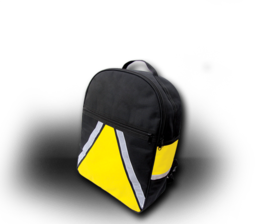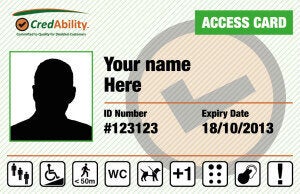The first and probably greatest skill disabled people have to quickly learn is problem solving. Since disabled people often live in a world that is unprepared for their specific needs, on a day to day basis they encounter barriers that require them to be creative and bend the rules on how things were intended to be used. The problem solving necessity has made some disabled people into fantastic inventors, using their experiences of solving specific problems to create products and services for other disabled people that makes their lives just that little bit easier. I would like to look to two examples of products and services designed by disabled people for disabled people.
The first is the Visibag from Steve of Safer to be Seen. As the name suggests, the bag is designed to go on the back of wheelchairs and scooters, as well as on walking frames, with the unique feature of having hi-vis material included in its design. As the winter nights are upon us, it is clear that disabled people go out in the evenings and at night, and like many road/pavement users, should consider hi-vis clothing and devices.

But there is very little point someone wearing a hi-vis vest or jacket if their back is hidden by the seat of their wheelchair or scooter, and so this compact rucksack style back gives the hi-visibility required. It is a simple and neat idea that can literally save lives, as well as providing many disabled people more independence and confidence to go out after dark. While not yet invented, I am sure the bag could be complimented with something for the front that is easy to wear for wheelchair users, like a hi-vis apron, or hi-vis attachments for those who wear harnesses. I am sure I could and should find someone that could make me a hi-vis protective helmet, so I really would be a shining light after dark!
The second example is something very different; something called an 'Access Card'. Designed by Credability, a social enterprise run by disabled people in Derby, this is a card like no other because it attempts to be a sort of accessibility passport, quickly informing businesses and other organisations of someone's specific needs in a hassle free manner. The problem with impairment and disability is that it is complex and the average person can not be expected to know what specific needs people have from just looking at them. But in a world of policies and procedures, many businesses want to ensure they are able to help the right people in the right way in a manner that can not be exploited by others.

So the aim of the scheme is to avoid those pitch fork battles disabled people have proving the needs they have, especially if they have invisible impairments, by assessing people needs, based on the social model barriers, and providing a card that will contain a number of symbols relevant to the needs they have, like using a wheelchair, needing a PA etc. The application is online and painless, with open questions, and assessed on common sense as most disabled people will know what needs make sense or looks made up. The card holder can then present the card to the business when asking for specific assistance and everyone involved knows what is going on.
The scheme is still in its infancy and slowly growing in terms of the number of businesses prepared to recognise it, but it has huge potential to make life easier for a lot of disabled people in a lot of situations, especially when and where their needs are not obvious. What I like about the scheme is that is not about proving someone is disabled, but highlighting the needs they have, however they define themselves, and so avoiding a welfarist focus. I think the scheme will grow and potentially revolutionise the relationship between disabled customers and businesses.
These are just two examples of what happens when disabled people design things for other disabled people, and it is always going to be these ad-hoc flashes of inspiration that will help disabled people in small ways that are only limited by our imagination.